When we say “the draw,” images of an old, western town on a hot summer day come to mind. The tumbleweed blows across the prairie as two gunslingers square off in the middle of town. The townsfolk quickly scurry indoors to escape the inevitable violence to come. Spurs jingle as the dusty gunslingers turn and face each other. The sun bears down on the two hostile men who will eventually become the killer and the killed. Background music can be heard setting the scene "wah wah wah waaaah," before they quickly draw their revolvers to see what destiny has in store.
For hunters, “the draw” may bring thoughts of something quite different from an old Western. While still exhilaratng and filled with anxious anticipation, the draw for hunting licenses is wildly more complex, modern and abundant with opportunities for many outcomes. The draw is utilized to distribute licenses to sportspeople interested in harvesting game animals. Hunting is still the Wyoming Game and Fish Department's primary management tool for species conservation, and the draw is a mechanism for equitable distribution of hunting licenses.
WHAT IS THE DRAW?
Wyoming's hunting draw allows individuals to apply for hunting licenses and permits that will be issued in drawings. Drawings are available for a multitude of species and areas, and the applications must be received electronically by midnight, Mountain Standard Time, of the specific deadline for the draw. All draw recipients are randomly selected through an automated system, and the process varies depending on the species and hunt areas. Sportspersons can select their first, second or third hunt area preference. Careful consideration and planning can increase drawing odds and potential for success.
HOW TO APPLY
Sportspersons must log on to the Game and Fish website using their username and password that is linked to their sportsperson's identification number. If they do not have a sportsperson's ID, they will be prompted to create an account. This account contains specific information relevant to the sportsperson, such as name, address, date of birth, all current licenses held by the individual and whether or not they have completed their hunter education certification. Sportspersons may apply in one or multiple draws and as an individual or with a party. All applications submitted as a party must have one individual as the organizer who submits the initial application for the group. After the party organizer submits the first application and pays the fee, the party identification number is then issued for other members to use when they apply. When applying as a party, all members of the group must apply for the same draw (i.e. species, full WHAT IS THE DRAW? price or reduced price, etc). Party numbers vary depending on Wyoming’s hunting draw allows individuals to apply for the species hunted. Elk parties can have up to six members, hunting licenses and permits that will be issued in drawings. sandhill crane party hunts are limited to two in the group.
APPLY OR BUY
The difference between apply or buy when it pertains to licenses is a clear-cut distinction. Applying for a license ensures the application will be going to a draw for a chance to be selected to attain a license. Buying a license guaran- tees issuance of the license at the time of purchase. In both instances, license quotas are proposed by wildlife managers in conjunction with herd objectives, harvest data and other relevant information vetted at public meetings and through public comment and then presented to the Wyoming Game and Fish Commission before entering the license system to provide an exact number of available licenses for purchase or to apply for in the draw. Buying a license means the license is available for purchase without going through the draw process.
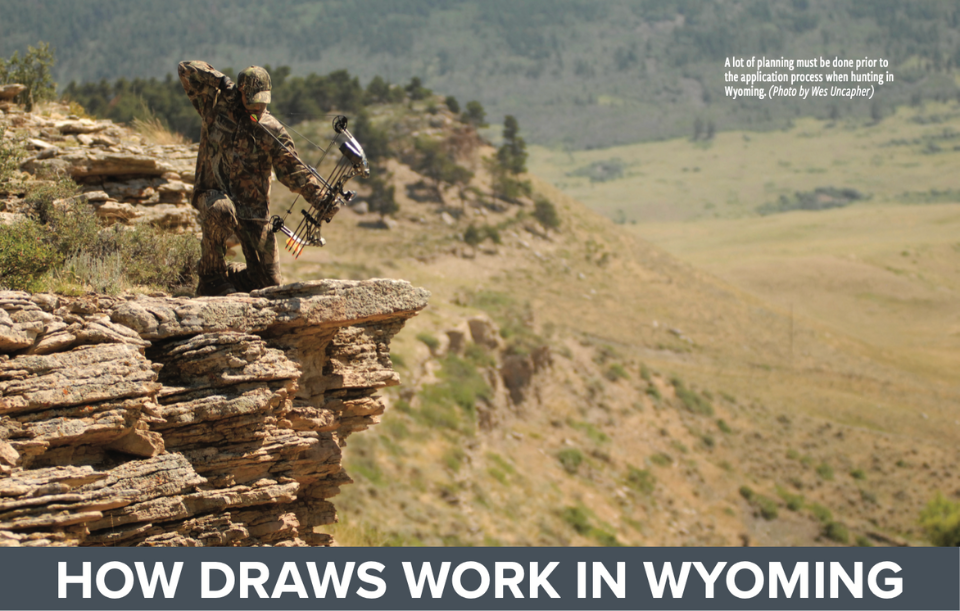
HOW DRAWS WORK IN WYOMING
For people entering applications for Wyoming’s big game draw, it can often be a complex process. Whether looking for access, finding a hunt area to draw with your preference points, deciding which part of the state you’d like to hunt or what type of license you’d like to apply for, there can be considerable planning leading up to the application.
That planning isn’t limited to hunters, though. Staff at Game and Fish work to ensure the draw runs smoothly and accurately. While different species have some differences in the flow of work for the draw Game and Fish conducts all limited quota draws similarly.
Following considerable efforts in preparation for the draw, the first step in conducting all limited quota draws is to assign random numbers, preference points and preference-point averages to every application participating in the draw. The system assigns two random numbers to each application. One random number is utilized to award licenses in the random draw, and the other number is to award licenses in a preference-point draw. All resident applications receive two random numbers and a preference-point total, even though the preference points and preference-point random number are only utilized when conducting the bighorn sheep or moose draw. This step can take considerable time if there are a large number of applications.
The preference-point average is the average of all party member’s preference points in a party application or the number of preference points for an individual applicant. The system utilizes this preference-point value when awarding licenses in a preference-point draw. In a preference-point draw, an applicant’s first choice is only considered for awarding licenses. During the random draw, the system awards licenses to all first-choice applicants before awarding licenses to a second and then third choice.
All party applications submitted participate in the draw with the same two random numbers and the same preference-point average. If the system selects a party when awarding licenses, all party members receive a license, which can cause additional licenses to be issued in that particular step in the draw. Licenses issued over the quota in a draw step are not subtracted from the subsequent step in the draw.
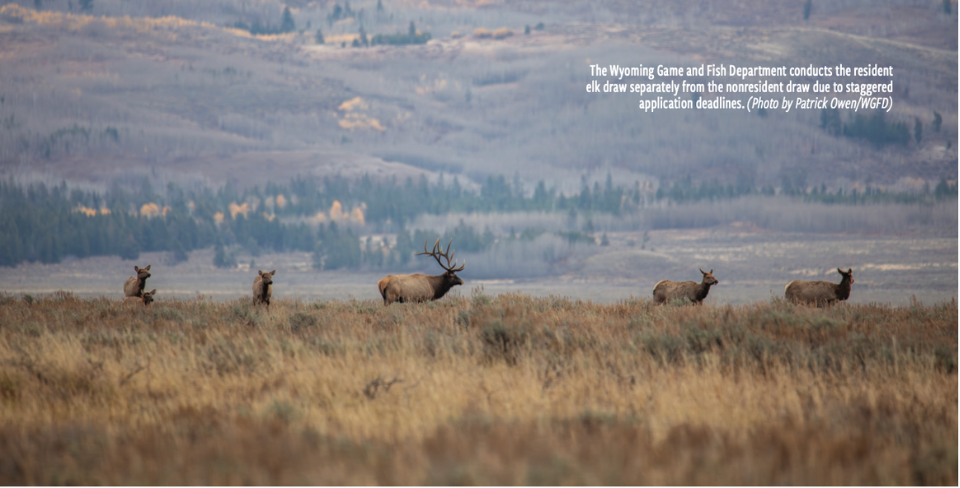
ELK INITIAL DRAW
The initial limited quota draw for elk has similar steps as antelope and deer, but the nonresident draw is conducted first. Game and Fish generates random numbers, assigns preference points and preference averages to all eligible nonresident applications. The Wyoming Game and Fish Commis- sion-approved quota is split 16 percent for nonresidents.
The nonresident draw is broken into three separate draws, each with a preference-point draw and a random draw. These three draws are the nonresident landowner draw, non- resident special draw and the nonresident regular draw. All nonresident quota available in each of these steps in the draw is split 75 percent for the preference-point draw and 25 percent for the random draw. All nonresident applications participate in their respective preference-point draw, even if the applicant or party does not have any preference points. Any unsuccessful nonresident application participates in the respective nonresident random draw. If a nonresident draws their first choice license even if it is in the nonres- ident random draw, their preference points are marked as unavailable for future draws.
The nonresident landowner draw is the first nonresident draw conducted. After the landowner draws, the remaining nonresident quota is split 40 percent to the special draw and 60 percent to the regular draw. The 40 percent quota allocated to the special draw is split 75 percent for the preference-point draw and 25 percent for the random draw. Licenses The Wyoming Game and Fish Department conducts the resident elk draw separately from the nonresident draw due to staggered application deadlines. (Photo by Patrick Owen/WGFD) are awarded in the preference-point draw and subsequently in the random draw. Any quota remaining after the special preference-point draw and random draw is added to the 60 percent allocated for the regular draw. The license quota remaining after the special preference-point draw is not added to the 25 percent in the random draw. The quota amount is split for the preference point and random draws and licenses are awarded in the nonresident regular draws. The license quota remaining after the regular preference-point draw is not added to the 25 percent allocated to the random draw.
The system conducts a second pass random draw on all unsuccessful special applicants, and subsequently a second pass random draw on all regular applications. These steps allow nonresidents an opportunity to obtain a license where the quota was not fully allocated in the respective draws. This concludes the nonres- ident elk draw and the results are released.
Game and Fish conducts the resident elk draw separately from the nonresident draw due to staggered application deadlines. The department assigns random numbers and preference points to all eligible applications. The resident elk draw does not utilize the preference points.
The initial resident quota is determined as the greater of 84 percent of the Commission-approved quota or the Commission-approved quota minus the nonresident elk licenses issued. The system awards resident landowner licenses from the resident quota in a random draw. Once the landowner draw is completed, the system calculates the resident quota by subtracting the landowner licenses issued from the initial resident quota. This is the quota available for the resident draw. The resident draw step awards resident licenses in a random draw. The system awards licenses to all first-choice applicants before awarding licenses to a second and then third choice. This concludes the initial draw and any quota remaining is available in the leftover draw.
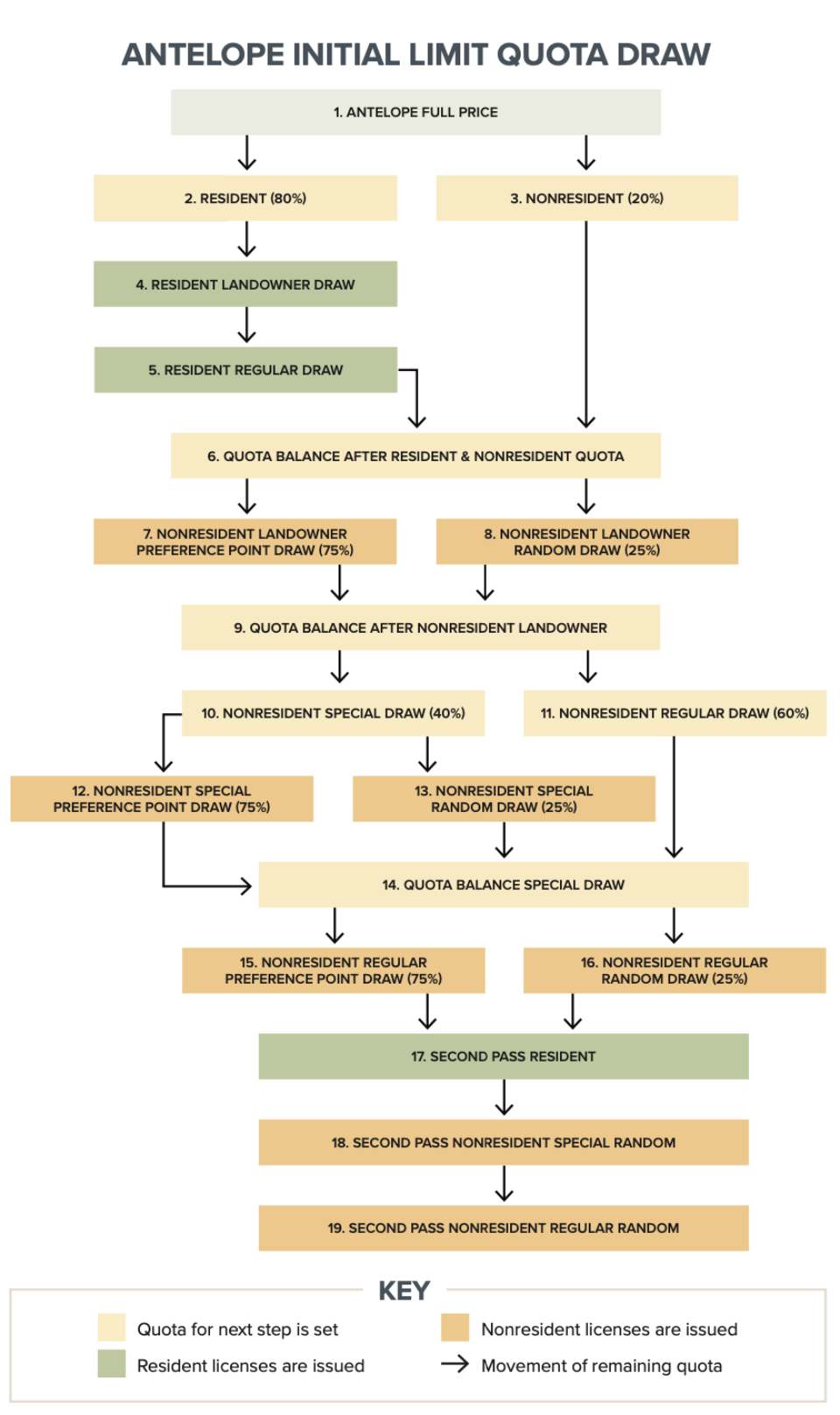
ANTELOPE AND DEER INITIAL DRAW
Game and Fish conducts the antelope and deer initial limited quota draws similarly. The Commission-approved quota is split 80 percent residents and 20 percent nonresidents. The system awards resident landowner licenses from the 80 percent resident quota in a random draw. Once the landowner draw is completed, the system calculates the resident quota available for the resident draw. The resident draw step awards resident licenses in a random draw. The system awards licenses to all first- choice applicants before awarding licenses to a second and then third choice.
After the resident draw is completed, any remaining quota not allocated to resident hunters is added to the nonresident quota, which was originally 20 percent of allocated licenses. The nonresident draw is broken into three separate draws, each with a preference-point draw and a random draw. These three draws are the nonresident landowner draw, the nonresident special draw and the nonresident regular draw. The nonresident quota for each of these draws is split 75 percent for the preference-point draw and 25 percent for the random draw. All nonresident applications participate in their respective preference-point draw even if the applicant or party does not have any preference points. Any unsuccessful nonresident application participates in the respective nonresident random draw. If a nonresident draws their first choice license, even if it is in the nonresident random draw, their preference points are marked as unavailable for future draws.
The nonresident landowner draw is the first of these draws conducted. After the landowner draws, the remaining nonresident quota is split 40 percent to the special draw and 60 percent to the regular draw. The 40 percent quota allocated to the special draw is split 75 percent for the preference point and 25 percent for the random draw. Licenses are awarded in the preference-point draw and subsequently in the random draw. Any quota remaining after the special preference point draw and the random draw is added to the 60 percent allo- cated for the regular draw. The license quota remaining after the special preference-point draw is not added to the 25 percent for the random draw. The quota amount is split for the preference point and random draws and licenses are awarded in the nonresident regular draws. The license quota remaining after the regular preference point draw is not added to the 25 percent allocated to the random draw.
The next step calculates the quota remaining after the nonresident regular draw by summing any remaining quota from the regular preference point and regular random draws.
The system conducts a resident second pass draw after the nonresident draws to issue any remaining quota to previously unsuccessful resident applicants. After the resident's second pass, the system conducts a second pass random draw for unsuccessful special applicants and subsequently a second pass regular random draw. These steps allow residents an opportunity to be issued licenses not fully allocated by nonresidents. This concludes the initial draw and any quota remaining is available in the leftover draw.
LEFTOVER DRAW
The leftover draw is conducted the same for elk, deer and antelope. Once all the eligible applications for the leftover draw are determined, the system assigns random numbers and preference points. The leftover draw does not use preference points or affect applicants' preference points if they draw a first-choice license. The quota available in the leftover draw is not split between residents and nonresidents.
The leftover draw is a random draw and licenses are awarded to residents and nonresidents based on the lowest random number. The leftover draw allows applicants to create party applications with residents and nonresidents because all applications participate in the same draw. Once this step of the draw is completed the draw results are released and the remaining quota will be available on a first-come, first-serve basis.
For first-time Wyoming hunters, some key steps in preparing exist. As soon as you decide a Wyoming hunt is appealing, you should start making a plan. Below are some things hunters should know as they prepare for their fall hunts and before applying in the big game draw.
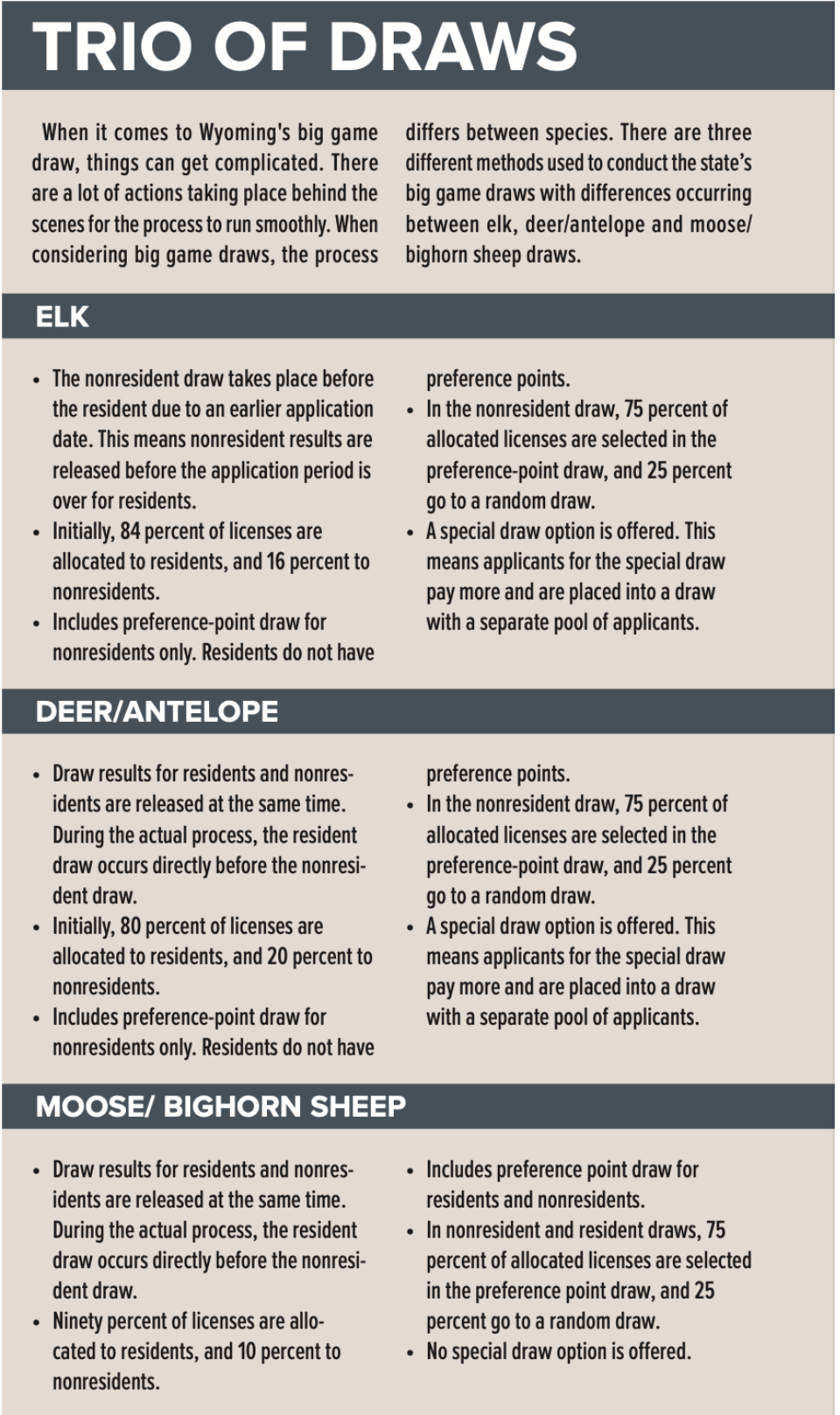
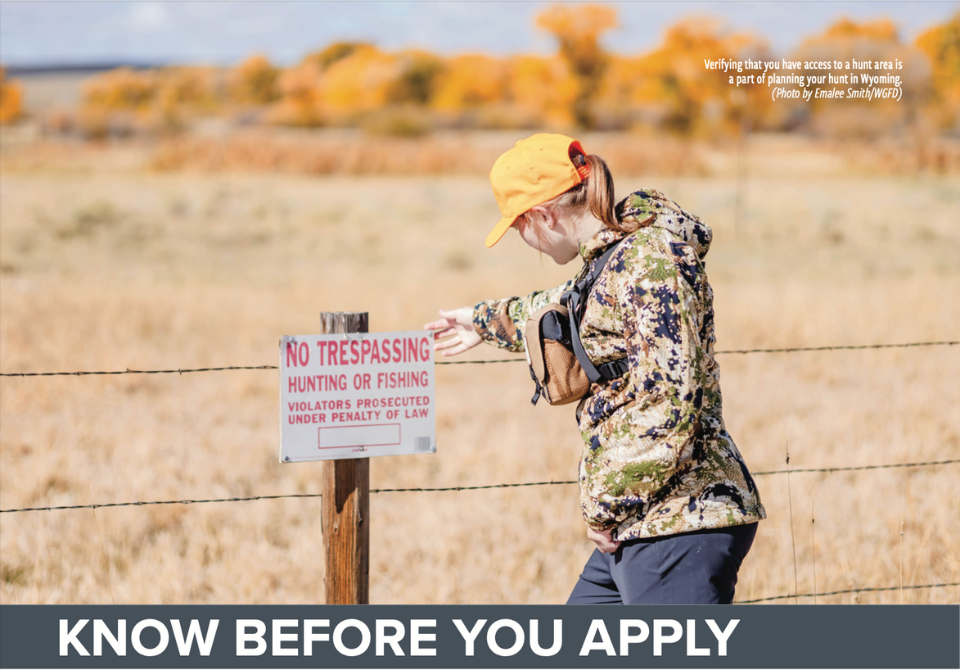
ACCESS
There are many factors to consider, and one of the biggest ones is access. Consider if you need an area with public access or if you have permission to hunt on private property. When considering access, it’s often a good idea to review the Wyoming Game and Fish Department's public access program. There are many access agreements in place for the public to hunt on private property through Access Yes. Each year the access areas are updated, but you can use the Public Access section on the Game and Fish website to view existing public access areas. The more time you have, the better prepared you will be when it is time to decide where you want to apply and for what species. Draw application periods for many big game hunts typically open on the first business day in January. The deadlines vary depending on your residency and the license you are applying for.
LICENSE TYPES
Once you have decided on the area and species you want to apply for, you will need to know what license types are available and what each type means. License types distinguish the price and any limitations of the license. Each license type can have specific limitations based on the area it is valid for and the management goals of the license. The table below explains license types in the broadest sense.
RESIDENCY
Another thing to consider is whether you are a resident of Wyoming or a nonresident. To be considered a resident of Wyoming, you must have lived in the state for at least 365 days before applying for or purchasing a resident license. You must submit a nonresident application if you do not meet these requirements or have made residency claims in another state within that 365-day period. Nonresidents have a shorter application period for the elk draw, and all non- resident license fees are more expensive than resident license fees.
HUNTER EDUCATION
One common misconception when it comes to applying for a license is that applicants are required to have completed hunter education before they can apply. Hunter education is only required while in the field hunting and is not required for the purpose of applying for or purchasing a license.
WILDERNESS AREAS
Further consideration for nonresidents should be given if the area they wish to hunt in includes wilderness areas. Any nonresident hunting big or trophy game in a wilderness area is required to be accompanied by a resident guide. Any resident of Wyoming with a hunting license valid for the same species of animal may acquire a resident guide license at no cost.
RESOURCES
Game and Fish offers great resources to help people make informed decisions about what hunts suit them. The Wyoming Hunt Planner on the Game and Fish website is the best place to start. The interactive guide to hunting in Wyoming is a gateway to land status maps, hunt area information, license types and drawing odds. And, it’s free.
If you can’t find what you need online, a phone call to the Game and Fish telephone information center or any regional office can guide you to the information you will need in order to plan your hunt.
GET SET UP
Another key point — each person applying for licenses through the electronic license system must set up a user account with a login and password. Once a user account is created, it is important for the sportsperson to remember their username and password. This login information is needed to access any account information in the future.
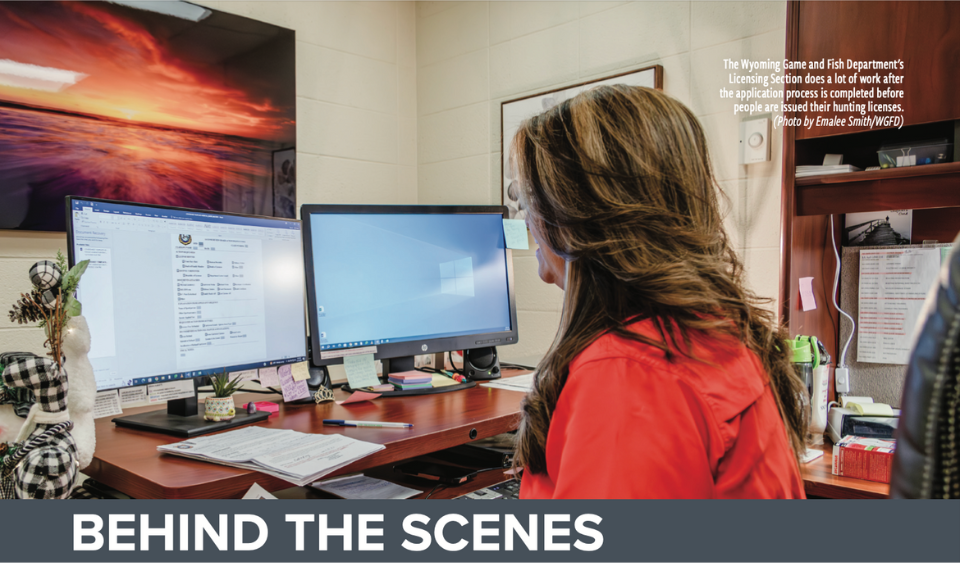
MAXIMIZE YOUR CHANCES
The Wyoming Game and Fish Department allows applicants to submit up to three license choices on a full-price antelope, deer or elk application and two choices on a cow or calf elk, doe or fawn deer or doe or fawn antelope application. Below are a few tips to make sure you are maximizing these options:
- Select different hunt areas and types for first, second and third choices. There is no advantage to listing the same hunt area and type in multiple choices. The draw awards to all applicants' first choice if licenses are available before awarding a license on a second or third choice. Therefore, if you do not draw the license on your first choice you will not draw it on your second or third choice.
- Review the random drawing odds to determine if a license may be drawn on a second or third choice. If there is not a 100 percent chance of drawing the license on your first or second choice, the license will not be drawn as a second or third choice. Many people make the mistake of putting a difficult-to-draw area as their second or third choice when even first-choice applicants have a reduced chance of success.
- Residents can apply for a general elk or deer license as their second or third choice during the initial draw. This is an effective way to make sure you are ready to hunt when the season opens, and you have already paid the nonre- fundable fees.
- The draw only looks at an applicant’s first choice for nonresidents during the preference-point draw. Nonresidents want to make sure they list their most coveted license as their first choice because if they draw their first choice license their preference points are marked as unavailable in future years. Nonresidents can draw their second or third-choice license without losing their preference points.
- Applicants should plan ahead to ensure they can hunt in a specific area if their second or third choice is successful. Often, licenses with difficult public access have better drawing odds for second or third choice, so make sure you have access before submitting your application. The department will not refund a license because you cannot obtain access.
ALL ABOUT PREFERENCE POINTS
Are you a nonresident dreaming of an epic hunting trip in Wyoming? Are you a Wyomingite looking to chase a bull moose in the Snowy Range? Even if you don’t plan on hunting soon, purchasing preference points now is a great idea. Preference points make planning a hunt easier and open more options for hunters in the future. In Wyoming, preference points rank applicants based on how many points they have. Hunters with more points have an increased chance of successfully drawing. In the moose, bighorn sheep and nonresident elk, deer and antelope draw, 75 percent of available licenses in each hunt area and license type are allocated to the preference-point drawing. Everyone who applies participates in the preference point drawing, even if they have no points. Allocation of licenses starts with those with the highest number of preference points and works down until all licenses are allocated. Each applicant is assigned a random number which determines the order of license alloca- tion for those with the same number of points. For party applications, all applicants’ prefer- ence point totals will be averaged to determine the preference point ranking. After the preference point drawing is com- pleted, all unsuccessful applications participate in the random drawing for the remaining 25 percent of licenses. This provides all hunters the chance to draw, even without preference points. The odds of being successful in the random draw are much lower. With the preference-point system, hunters can use drawing odds provided by Game and Fish to determine how many points it takes to draw a license for a specific hunt area. If planned correctly, hunters can almost guarantee a high-quality hunt over the course of a few years by purchasing preference points annually. In Wyoming, hunters can buy points without applying for a license from the first business day of July through Oct. 31. Hunters can apply for one preference point for each species allowed per year. For residents, preference points are available for moose and bighorn sheep; for nonresidents, points are available for moose, bighorn sheep, elk, deer and antelope. Hunters must apply for a point at least every two years to maintain their balance and avoid losing their accumulated points.
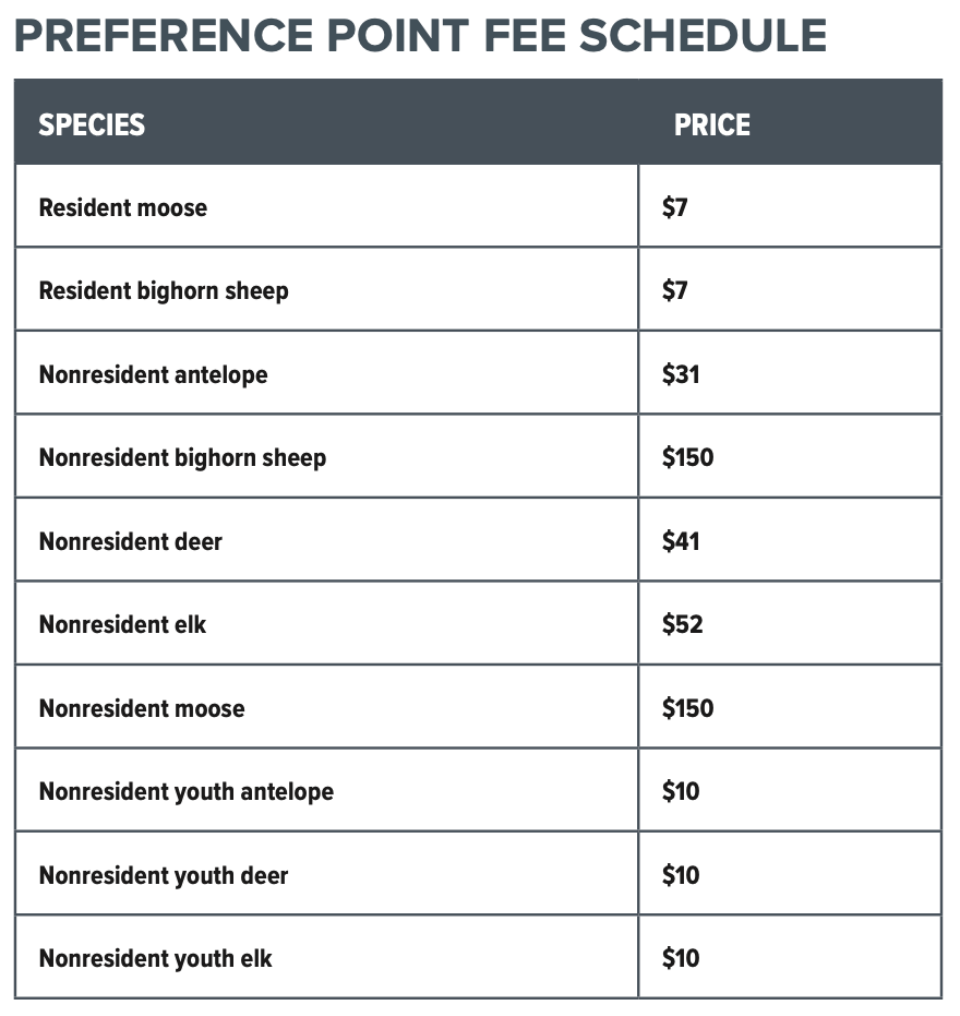
PLAN AHEAD FOR YOUTH HUNTERS
Set up the youth in your life to be able to draw a highly-coveted tag by purchasing youth preference points. Youths can apply for preference points when they are 11 years old at the time of submitting a preference point- only application but must be 12 years old by Dec. 31 of that year. In Wyoming, nonresi- dent youth can purchase preference points for antelope, deer and elk at the reduced price of $10 between the ages of 12-17. APPLICATION STRATEGIES There are some key things to remember when utilizing preference points in Wyoming. To maintain your preference points, do not apply for an easy-to-draw area as your first choice. Those successful in drawing their first choice area will lose their accumulated points. This will diminish the odds of drawing a license in a hard-to-draw area for several years until you build up more preference points. If you want to hunt more often without using your preference points, continue to apply for your hard-to-draw hunt area as a first choice and apply for an easy-to-draw hunt area as your second choice. By reviewing the random drawing odds from previous years, you can find hunt areas with good odds of drawing a license as a second and possibly a third choice. Drawing odds can and do change from year to year as applicants shift their pref- erences for specific hunt areas and generate high demand. The prior year’s drawing odds, found on the Game and Fish website through the Hunt Planner, are a useful indicator of relative odds but provide no guarantees. NONRESIDENT ANTELOPE, DEER AND ELK For nonresident full-price elk, deer and antelope, preference points can be accu- mulated by applying for a preference point during the preference point-only applica- tion period. For nonresident full-price elk, full-price deer and full-price antelope, an individual’s accu- mulated preference points are only considered in the initial drawing for the applicant’s first choice in the preference-point drawing.
When applying for a nonresident elk license, any full-price license will use your points. This includes the type 4 and type 5 full-price antlerless elk licenses. If you wish to apply for a cow/calf or antlerless elk license and do not want to use your points, apply for the reduced-price cow/calf license. There are no preference points for reduced-price licenses and applicants do not lose their points if they are successful. For nonresi- dent full-price elk, an applicant will lose all accumulated preference points if they draw their first choice license in the initial limited quota drawing.
MOOSE AND BIGHORN SHEEP Preference points are available for residents and nonresidents in the moose and bighorn sheep drawings. For moose and full-price bighorn sheep, preference points can be accu- mulated by submitting an application for the limited quota drawings or by applying for a preference point during the preference point-only application period using the online system. All resident applicants who are unsuccess- ful in drawing a moose or full-price bighorn sheep license will automatically be awarded a preference point each year they participate in the limited quota drawing. If opted in on the application, nonresidents will have the applicable moose ($150) and/or full-price bighorn sheep ($150) preference point fees deducted from their license refund. Residents will receive a full refund of their license fee. If residents don’t participate and nonres- idents don't opt in for a preference point in the limited quota drawing for moose or full-price bighorn sheep, they may apply for a preference point during the preference point-only application period using the online system. For moose and full-price bighorn sheep, an applicant will lose all accumulated preference points if they draw a license or if they fail to be awarded a preference point within two consecutive years by either participating in the limited quota drawing or applying for a preference point during the appropriate application period. Type 1 moose and full-price bighorn sheep licenses are once-in-a-lifetime licenses, so successful applicants for these are no longer eligible to purchase preference points for the species. After five years, successful Type 1 moose applicants may purchase points for a Type 4 license.
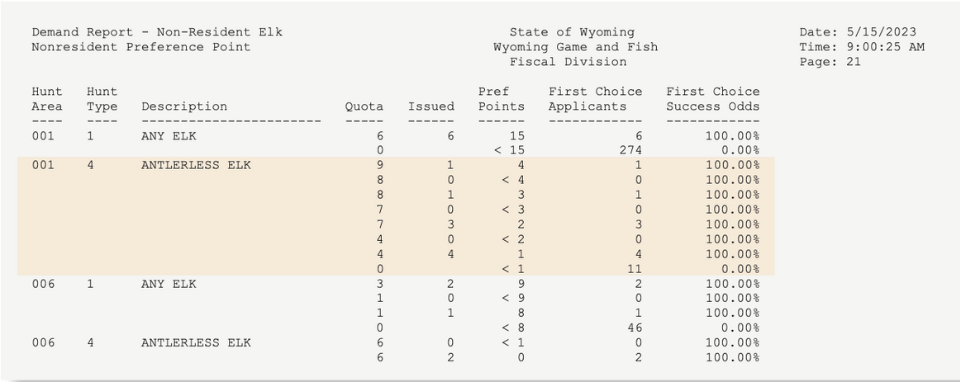
PLAYING THE ODDS
Hunting can be a gamble, but playing the odds can increase your chance of success — at least when it comes to the draw. Learning how to read drawing odds will help you to be a more informed license applicant. Knowing the likelihood of drawing a license will help you apply to the best hunt areas and use your preference points most effectively.
Drawing odds can be found online through the hunting section of the Wyoming Game and Fish Department website or on the Hunt Planner. When looking at the drawing odds, they are always from a previous year's drawing. The actual outcomes of any year will be different depending on the applicants and the quotas fro the given year. The odds are meant to help with planning your hunt but cannot be relied on with complete certainty.
Pictured above is an example from the nonresident preference-point draw. To read the drawing odds, begin by choosing the species, hunt area and license type. This example shows the nonresident full-price elk preference-point draw for Hunt Area 1, Type 4 licenses. In the preference-point draw, only the applicant's first choice is considered. In this example, the first choice applicants column lists how many people chose Hunt Area 1, Type 4 as their first choice. Each row of the first choice applicants column relates to the number of preference points each number of applicants had. For example, one person applied to Elk Hunt Area 1, Type 4 with four preference points, and that person was successful.
For elk, Hunt Area 1, Type 4 there were nine licenses allocated to the nonresident preference-point draw. Since nobody applied to this draw with more than four preference points, the person who applied with four points was issued one of the nine licenses available, resulting in 100 percent chance of getting the license. There were more licenses available than the applicants with that number of preference points. Moving through the table, there are now eight licenses available, one less because a license was issued to the applicant with four points. In this case, no one applied with more than three or less than four preference points. Partial preference points can occur when hunters apply in a party and their preference points are averaged.
There was one applicant with three preference points next, and that person drew with 100 percent certainty, reducing the number of licenses to seven. There were no applicants who had between two and three preference points, leaving seven licenses available. Three people applied with two preference points and drew the license, leaving four more licenses wich were allocated to four people who applied with one preference point. The 11 people who applied with no points did not draw a license because the quota was already reached.
In this particular example, if you had no preference points the odds of drawing a license were 0 percent, but if you had at lease one point your odds were 100 percent.
There also are random drawing odds, which are read a little differently.
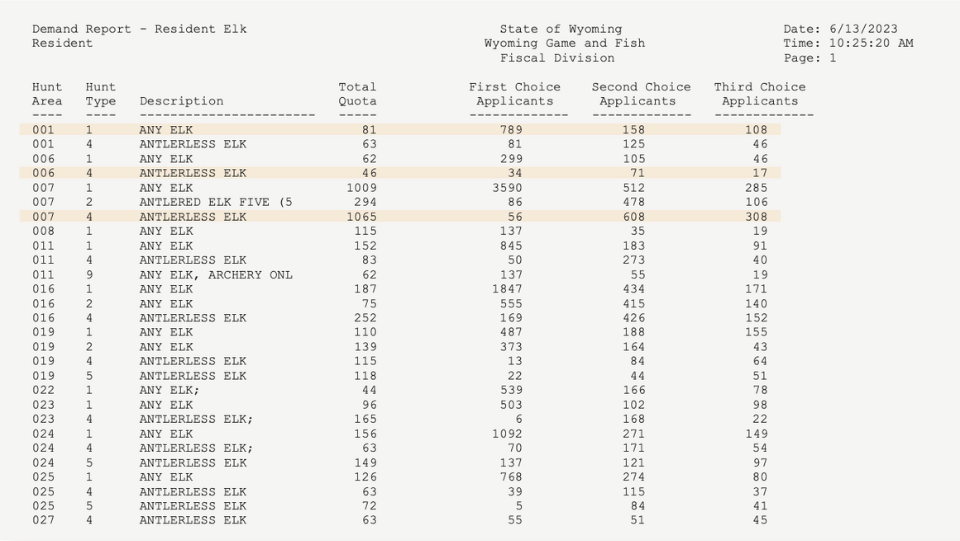
Again, the report breaks down the hunt area, license type and quota in the left columns. In this example resident elk Hunt Area 1, Type 1 licenses had a quota of 81 licenses; 789 applicants listed this license as their first choice, and 81 were randomly selected and issued the quota of tags. This resulted in a 10.26 percent chance of drawing. For this license, no applicants were issued this license as a second or third choice because all licenses were already allocated to first-choice applicants.
If you look at the same report for elk Hunt Area 6, Type 4 licenses, there was an available quota of 46 licenses, and all 34 applicants who listed this license as their first choice were successful. That left 12 licenses available for 71 applicants who listed the license as their second choice. There was a 16.9 percent chance of drawing this license as a second choice.
Looking at the same report for elk Hunt Area 7, Type 4 licenses there was an initial quota of 1,065 licenses. The total number of applicants including first, second and third choices was 972 applicants. That left 93 licenses unallocated in the resident random draw. In the resident elk draw, these licenses would be available in the leftover draw. In deer and antelope, resident licenses are added to the initial quota for nonresidents.
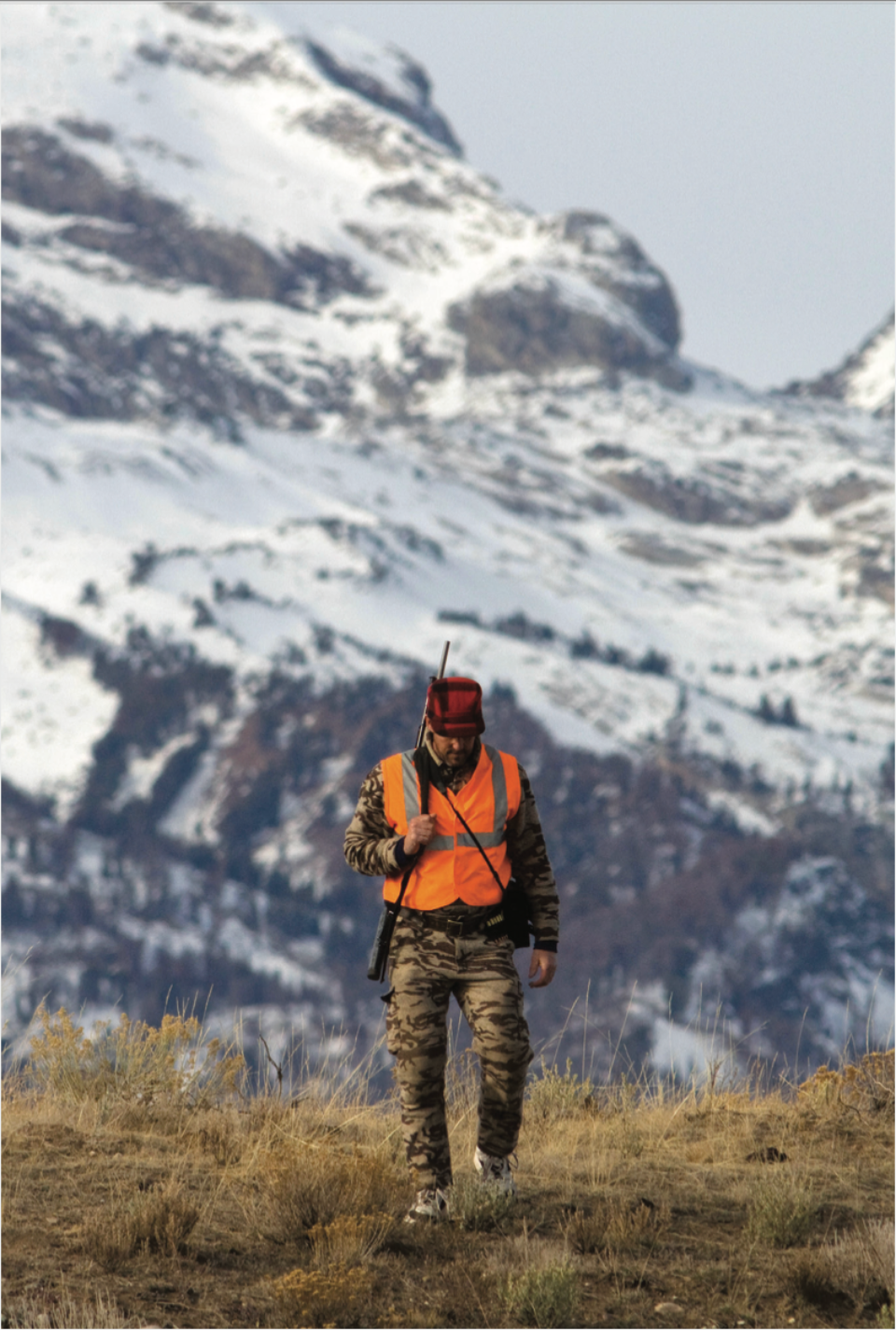
Once a hunter has submitted a draw application and the application deadline has passed, many wait with anticipation to see if they are successful. It can be a time filled with hope and anxiousness as wishful applicants wait for results and start making tentative plans for a fall hunt. It’s during this time of waiting that some real heavy lifting takes place at the Wyoming Game and Fish Department.
Even before the application deadline, Game and Fish puts a lot of leg work in to ensure the process runs smoothly. Through the season-setting process, the Wyoming Game and Fish Commission is presented with proposals for how many licenses should be allocated for each species, area and type. Once the Commission approves the licenses, Game and Fish loads the licenses into the draw system. The Licensing Section generates a report showing every approved license by hunt area and type, the total quantity of licenses and the split of the total licenses for residents and nonresidents. Then the Licensing Section verifies the report and sends it to the Wildlife Division Administration for approval. This is all done to prepare to conduct the draws.
While it would be great for hunters to get results immediately after the application period ends, the draw doesn’t happen at the press of a button. Several important steps occur after the application period has closed before the draw can begin. First, personnel review customer records to ensure applications haven’t been entered under more than one profile. If someone is found to be entered under two or more accounts, Game and Fish merges those records in the system. Merging customer records updates preference points the applicant has across all accounts so their application participates in the draw with all of their preference points.
Next, an automated review process evaluates each application to ensure the applicant is eligible for the draw and there are no errors in the application. If a customer has more than the allowed number of applications in the system for the draw, the excess applications are marked as ineligible. This may occur when a customer submits applications under two different records. The system flags application records in this step if party applications do not match or there are more than the allowed number of party members in the group. This error occurs when customers request to add members to a party after they have submitted their application. This also ensures customers have not submitted duplicate applications. The Licensing Section reviews and approves the report generated by the system before proceeding to the final step. The last step is to compare the applications received by Game and Fish, including those not eligible to participate in the draw, with the dollars on deposit. In this step, Game and Fish balances the applications submitted with the revenue from those applications. This ensures all applications included for the particular species match the daily revenue balance. This step is critical and ensures every paid application participates in the draw, or the department flagged the application as ineligible in previous steps. Depending on the number of applications, these steps can take a day or multiple days to complete. If at any point in these steps a change is made to update an application to eligible or ineligible, all of these steps must be completed again from the beginning. A draw cannot begin until all of these steps are completed.
After the draw is completed, the department reviews the draw and prepares to release the results. After the review process, Game and Fish must create the licenses for all successful applicants. The department creates the drawing odds reports to publish on the Game and Fish website, loads the results and generates unique links for customers to view their results. Before the release of draw results, Game and Fish updates preference points for applicants successful in drawing their first choice. Applicants who drew their first choice have their preference points set to unavailable for future draws.
Following the release of the results, Game and Fish also works with the credit card processor so unsuccessful applicants are refunded their license fee. Refunds are issued the day after the draw results are released. During the application process, applicants can elect to be charged for conservation stamps and other licenses if they are successful in drawing their license. Game and Fish works with the credit card processor to add these additional licenses for successful applications. The department receives a file from the credit processor showing the charge was approved or declined. For approved credit card charges, the department creates the licenses for the customer.
The final steps are to generate the license print files, print the licenses and mail the licenses. The system generates license print files which are proofed for accuracy by the Licensing Section of Game and Fish. The licenses are printed at the headquarters location on a production printer. In June, Game and Fish prints approximately 100,000 licenses for the antelope, deer and resident elk draw. All these licenses are proofed, inventoried and audited to ensure all licenses are printed. The licenses are printed two per page, therefore after the audit is complete, the printed licenses are cut to prepare for mail- ing. The mailing process includes inserting all licenses and inserts into an envelope, sealing the envelope and putting the envelopes in trays. Staff then sorts envelopes into trays to prepare them to be picked up by the United States Postal Service.
— Game and Fish Communications and Education Chief Nish Goicolea, former Licensing Section Manager Jennifer Doering, Wyoming Wildlife Editor Tracie Binkerd, Green River Region Information and Educa- tion Specialist Regina Dickson and Public Information Officer Breanna Ball contributed to this article.
